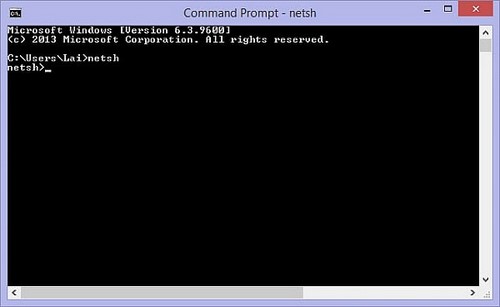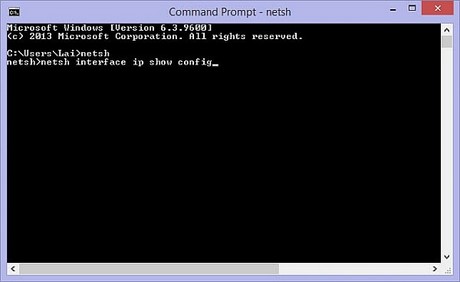How to configure TCP/IP using CMD command on Windows
Instructions for using Netsh to set up TCP/IP on Windows, from setting static IP, enabling DHCP to configuring DNS. Useful solution for administrators and advanced users.
Configure TCPIP using Cmd command
Step 1 : First, open CMD and then enter the netsh command to use Netsh.exe.

To set up TCP/IP you enter the command.
| netsh interface ip show config |

To set a static IP, enter the command.
| set address local static 192.168.2.2 255.255.255.0 |
In which 192.168.2.2 is the IP, and 255.255.255.0 is the subnet mask

To set up DHCP mode you enter the command.
| set address name= 'Local Area Connection' source=dhcp |

To configure DNS you enter the command.
| set DNS 'Local Area Connection' static 192.168.2.1 |
Where 192.168.2.1 is the DNS address.

To exit the netsh.exe environment you type.
| exit |

If you want to check TCP/IP information using CMD command, you use the command.
| ipconfig /all |

You can use Netsh to configure TCP/IP on Windows flexibly, from setting static IP, enabling DHCP to editing DNS. If you need to manage the network system in depth, CMD commands will help check IP addresses quickly and accurately.
You should read it
- 2 steps to backup Zalo messages on your computer
- List all shortcuts in Adobe XD
- Add the QR code scanning function to Control Center on iOS 12
- Dell lost second place to Acer
- Access commonly used items in Windows 7 with Jump Lists
- Kaspersky Internet Security 2011 Beta causes the computer to hang
- How to reset and re-run the search index on Windows 10
- How to Change the Language of Your Computer (Windows XP)
May be interested
- Set command in Windows
 the set command helps show, set or remove cmd.exe environment variables.
the set command helps show, set or remove cmd.exe environment variables. - Del command in Windows
 the del command deletes one or more files. this command is the same as the eraser command.
the del command deletes one or more files. this command is the same as the eraser command. - 10 useful commands in Windows you should know
 command prompt is used to execute batch files, perform tasks quickly, help you troubleshoot and solve some windows problems when the system crashes. however, not all commands in windows are useful and must be done regularly. with the 10 command lines in the following article it is very useful even if you are not an administrator.
command prompt is used to execute batch files, perform tasks quickly, help you troubleshoot and solve some windows problems when the system crashes. however, not all commands in windows are useful and must be done regularly. with the 10 command lines in the following article it is very useful even if you are not an administrator. - How to use the option equivalent to the 'ls' command in Windows
 the 'ls' command (note ls, not is) is one of the first terminal commands veterans teach to linux beginners.
the 'ls' command (note ls, not is) is one of the first terminal commands veterans teach to linux beginners. - The command reg add in Windows
 the reg add command adds new subkeys or entries to the registry.
the reg add command adds new subkeys or entries to the registry. - Rem command in Windows
 the rem command helps write comments (comments) in a batch file or config.sys.
the rem command helps write comments (comments) in a batch file or config.sys. - Instructions for using Command Prompt
 deep in windows is a command-line world that is obscure. in this article, we will show you how to solve errors and make your computer more secure.
deep in windows is a command-line world that is obscure. in this article, we will show you how to solve errors and make your computer more secure. - Rd command in Windows
 the rd command helps delete a directory
the rd command helps delete a directory - Cmd command in Windows
 the cmd command starts a new version of the command interpreter, cmd.exe. if used without parameters, cmd will display copyright information and the version of the operating system.
the cmd command starts a new version of the command interpreter, cmd.exe. if used without parameters, cmd will display copyright information and the version of the operating system. - How to use the command history function in Command Prompt
 command prompt is an extremely familiar command for anyone using windows operating system. besides, a lot of current software also supports the command line to perform actions on the command prompt window, instead of on the screen.
command prompt is an extremely familiar command for anyone using windows operating system. besides, a lot of current software also supports the command line to perform actions on the command prompt window, instead of on the screen.










 How to customize the Power button function on PC, laptop
How to customize the Power button function on PC, laptop What is HomeGroup? How to use and set up on Windows
What is HomeGroup? How to use and set up on Windows Instructions to fix Bad hard drive errors simply and effectively
Instructions to fix Bad hard drive errors simply and effectively The simplest way to create a virtual drive using Virtual Drive
The simplest way to create a virtual drive using Virtual Drive Detailed instructions for installing and using VMware virtual machines
Detailed instructions for installing and using VMware virtual machines The simplest way to read and open Host file on Windows XP/7/8/10
The simplest way to read and open Host file on Windows XP/7/8/10